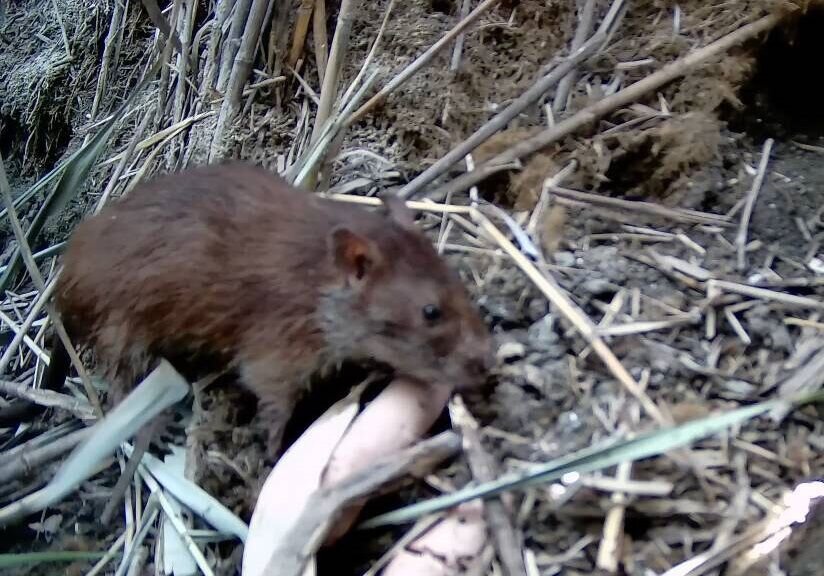Rare long-tailed nesokia seen in Hour al-Azim wetland

TEHRAN – New images of the long-tailed nesokia (Nesokia bunnii), one of the rarest and endangered rodents of the world, were recorded in Hour al-Azim wetland on Tuesday.
Long-tailed nesokia, the same as the Persian yellow deer and the Persian leopard, is listed as a critically endangered species on the International Union for the Conservation of Nature (IUCN) Red List. Therefore, it requires special conservation efforts to ensure its survival.
The long-tailed nesokia is endemic to the Mesopotamian Marshes and is restricted to Hour al-Azim, Iran, and parts of the southern wetlands of Iraq.
The first record of the long-tailed nesokia in Mesopotamia was identified by the research team of the protected area in Hour al-Azim in the Iranian year 1400 (2021-2022).
It was subsequently published in the world's most prestigious mammal magazine, named Mammalia, with the title of ‘First record of the elusive and endangered long-tailed Nesokia, Nesokia bunnii, in Iran’. It was then added to the list of mammals of the country.
In the progression of studying the habitat, demographic, and genetic distribution of this world's rare species, a number of long-tailed nesokia killed in road accidents or by dogs have been transferred to the gene banks for the preservation of genetic materials.
Also, camera traps have been installed in 16 points of the wetland as well as its margins, which managed to record significant images of the species in the natural habitat which will contribute to monitoring the population and activity of the species during the day and night, IRNA quoted Ali Sajad Jalali, an official with the department of environment, as saying.
Long-tailed nesokia is one of the rarest and most unknown species of rodents and mammals in the world; these studies and images have tremendous value in zoology, the official added.
Long-tailed nesokia is a large rat completely different from other Nesokia species, namely Nesokia indica (short-tailed Nesokia). It is bigger in size and weighs around 500 grams. The length of the tail is equal to or even longer than the length of the head and body, it has a rufous dorsal pelage, a white belly, and a specific gray facial mask, Jalali added.
Habitat destruction, lack of adequate water supply, road construction, fires, and the existence of dogs are among the threats that can lead to their extinction.
The species depend on small islands in Hour al-Azim wetland so its preservation is essential to ensure the survival of this species in the world.
Endangered species
There are many threats to endangered wildlife species, including mammals, reptiles, amphibians, fish, and birds.
Habitat destruction, fragmentation, and modification caused by human-led activities such as industrial and residential development, logging, crop farming, livestock grazing, mining, road and dam building, and pesticide use have taken an extreme toll on threatened and endangered wildlife populations at an alarming rate.
Currently, about 128 species of animals and vertebrates in the country are at risk of extinction, some of which are not in good condition, and amphibians are the most vulnerable in this area.
Persian zebra, Asiatic cheetah, black bear, and yellow deer are in danger of extinction.
Zebras exist in two habitats in Iran; one is in the Turan protected area in the south of Semnan province, where there are about 250 zebras, and the other is in the Bahramgur protected area in the southeast of Fars province, where 1,200 zebras are kept.
The Persian zebra population is estimated to be around 1,500, although the zebra is considered an endangered species according to both national and international regulations.
Asiatic cheetah ranks second among Iran's endangered species. Including the cheetahs that have probably not been identified, the population of this species in Iran is estimated to be below 30.
Persian yellow deer is also one of the most important species in the world. According to the list provided by the International Union for Conservation of Nature, these deer are in the EN category and the red list, which is considered to be in danger of extinction.
The deer have been released in a limited number of habitats in "Ashk" Island, West Azarbaijan province, and "Dez" National Park, Khuzestan province.
They are also kept in reproduction and breeding centers in Ilam, Yazd, Fars, West Azarbaijan, and Mazandaran provinces.
Asian black bear, which is known as the Baluchi black bear, is another endangered species in the country. It lives mainly in forest areas, especially in mountainous areas at altitudes of 500 to 2,700 meters, and is found in Kerman, Hormozgan, and Sistan-Baluchestan provinces in very low quantities.
Paying attention to the biodiversity and wildlife inside the country will not work alone, and it is important to use international capacities to manage the current critical situation and prevent the extinction of endangered species.
Action plans underway
The Department of Environment (DOE) has developed action plans for the conservation of 23 endangered species and the plans are being implemented in the country.
The plans intend to address species such as cheetah, brown bear, leopard, black bear, Persian yellow deer, Persian zebra, and hunting birds from among 86 endangered species.
Over the past few decades, different factors such as land use change, drought, agricultural development, climate change, and mining activities have led to the destruction of natural habitats and the reduction in the number of prey which with the passage of time has declined wildlife population and pushed some species to the brink of extinction.
According to the DOE’s latest report, 86 species in the country are critically in danger of dying out.
The Department of Environment is planning to create action plans for 20 more endangered species.
MT/MG
Leave a Comment